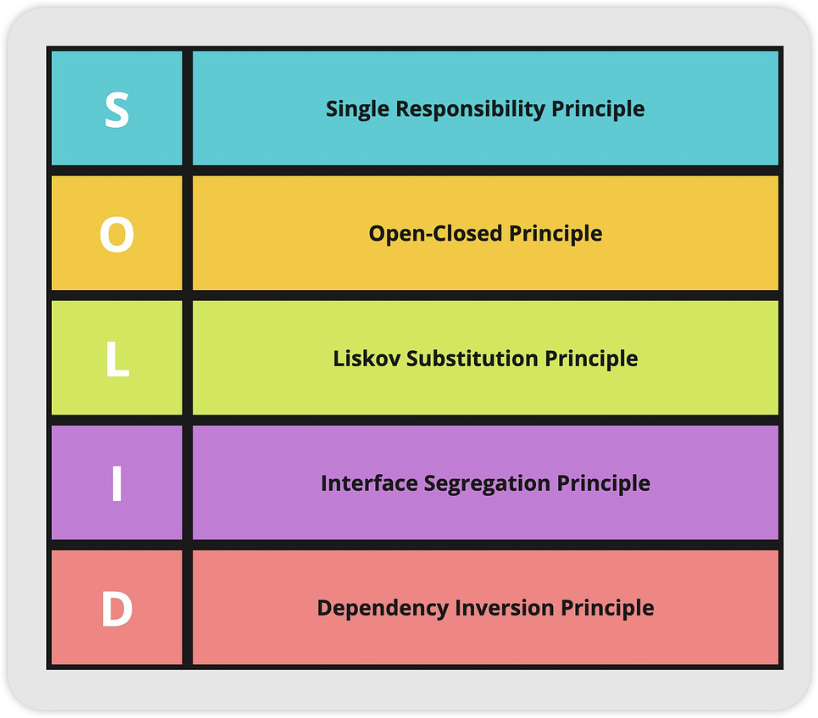SOLID 原则是一组设计指南,可帮助开发人员编写更可维护、可扩展和可测试的代码。
构建软件是一个不断变化的挑战。为了应对这种复杂性,开发人员依靠经过验证的设计原则来编写健壮、适应性强且易于管理的代码。其中一组原则是 SOLID(由 Robert C. Martin 首先提出)。
SOLID 代表:单一职责、开闭式、里氏替换、接口隔离和依赖倒置。每条原则在提高程序的可维护性、可扩展性和可测试性方面都发挥着至关重要的作用。

尽管Golang不是纯粹的面向对象语言,但我们仍然可以应用SOLID原则来改进我们的Go代码。在这篇文章中,我们将深入研究每个原则,探索其含义,并发现如何在 Go 中有效地利用它。
S - 单一责任原则
单一职责原则 (Single Responsibility Principle) 规定结构/包应专注于单个明确定义的功能区域。将每个结构想象成具有特定专业知识的专家。这可以使您的代码保持井井有条并降低复杂性。对结构功能的更改是隔离的,使维护和未来的更新变得轻而易举。
A class should have one, and only one, reason to change.
Robert C. Martin
Go 擅长结构体,而不是类。但不用担心,SRP 建议在这里仍然适用。将每个结构想象为一个紧密结合的模块,负责一个明确定义的任务。这种模块化方法可以保持代码整洁、降低复杂性并提高可维护性。
SRP 的魔力也延伸到了 Go 包中。理想情况下,包应该专注于单一功能领域。这可以最大限度地减少依赖性并使事情井井有条。通过在结构和包中采用 SRP,您可以为干净、可维护和可扩展的 Go 应用程序奠定基础。
一些好的包的例子:
- coding/json - 提供 JSON 的编码/解码。
- net/url - 解析 URL。
不太好的例子:
- utils - 杂项垃圾场?
让我们看一个 Go 中的示例,其中有一个 struct Survey,其中包含一些属性和几个方法:GetTitle()、Validate() 和 Save():
|
|
我们当前的 Survey 结构似乎设计得很好,除了 Save() 方法之外。它的存在违反了 SRP。由于数据存储和调查逻辑位于同一结构中,维护、测试和扩展变得更具挑战性。
为了遵守 SRP,我们应该区分这些问题:
|
|
现在,Survey 结构只负责管理调查数据,而 Repository 接口和 InMemoryRepository 结构则处理数据库操作。
O——开闭原则
开闭原则 (Open-Closed Principle) 是良好软件设计的基石。它规定软件实体(类、模块、功能等)的设计应考虑到未来的增长。这意味着它们应该开放扩展,允许添加新特性和功能,同时保持关闭修改。修改现有代码来适应新的需求是有风险的,因为它可能会引入错误并使未来的维护成为一场噩梦。
A module should be open for extension but closed for modification.
Robert C. Martin
回到我们的调查示例。让我们向结构体添加一个新方法 - Export(),它可以将调查数据导出到某些外部服务/存储中。由于可能有多个导出目标,因此 Export() 方法有一个 switch 块。
|
|
如果我们需要添加对其他服务的支持,则当前的实现需要修改,这违反了 OCP。
为了遵守 OCP,我们可以定义一个 Exporter 接口,这样我们就可以为不同的目标添加新的导出器,而无需修改现有的代码库。
这遵循 OCP,提高了代码的灵活性和可维护性。我们的代码对扩展开放(我们可以添加新的导出器),但对修改关闭(我们不需要更改 Export() 函数)。
L - 里氏替换原理
里氏替换原则 (Liskov Substitution Principle) 确保可以在不破坏程序的情况下交换对象。虽然 Go 缺乏传统的继承,但接口实现了这一点。任何类型都可以通过具有与其签名相匹配的方法来“实现”接口。这提高了灵活性——使用接口的代码可以与各种类型一起工作,只要它们履行合同。
If S is a subtype of T, then objects of type T may be replaced with objects of type S, without breaking the program
B. Liskov
在 Go 中,LSP 的一个很好的例子是 io.Writer 接口:
|
|
io.Writer 的神奇之处在于它能够将字节切片写入任何流:文件、HTTP 响应等。
现在回到我们的 Survey 结构,我们可以添加一个方法 Write() 来将调查对象写入某处。我们可以简单地让它接受 io.Writer,这样实现就可以决定将其写入何处。
这个函数的用户现在有很大的灵活性,因为他们只需要使用一些实现 io.Writer 的结构,例如:
|
|
I——接口隔离原则
接口隔离原则 (Interface Segregation Principle) 规定客户端不应被迫依赖于他们不使用的接口。这一原则鼓励创建更小、更集中的界面,而不是大型、单一的界面。
Clients should not be forced to depend on methods they do not use.
Robert C. Martin
同样,Go 的 io 包就是一个很好的例子。它有多个小接口及其组合,例如 io.Reader、io.ReadWriter、io.ReadCloser、io.ReadWriteCloser 等。
在我们的调查示例中,假设我们有多种问题类型:文本和下拉列表。我们可以定义一个通用的 Question 接口。
|
|
Question 界面中的 AddOption() 方法很突出。这对于 TextQuestion 来说没有意义并且违反了 ISP。以下是我们如何遵循 ISP 并改进设计:将问题界面拆分为更小、更集中的界面:
|
|
D - 依赖倒置原则
依赖倒置原则 (Dependency Inversion Principle) 规定高级模块不应依赖于低级模块。两者都应该依赖于抽象。
简单来说,DIP 建议您的代码应该依赖于接口或抽象类,而不是具体的类或函数。这种控制反转减少了软件不同部分之间的耦合,使其更加模块化、可扩展且易于测试。
Abstractions should not depend on details. Details should depend on abstractions.
Robert C. Martin
作为示例,我们可以引入一个处理调查创建的 SurveyManager 结构,您可以想象它依赖于数据库。
|
|
这里糟糕的设计是它严重依赖InMemoryRepository,违反了高层模块不应该依赖低层模块的原则。
同样,接口和构造函数可以帮助我们解耦事物:
|
|
结论
SOLID 原则是构建干净、可维护和可扩展软件的基石。虽然具体的实现细节可能会因编程语言的不同而有所不同(例如在 Go 中使用接口组合而不是继承),但 SOLID 的核心原则仍然普遍适用。通过遵循这些原则,开发人员可以编写更具适应性、更容易测试并最终更能适应变化的代码,无论他们选择哪种语言。